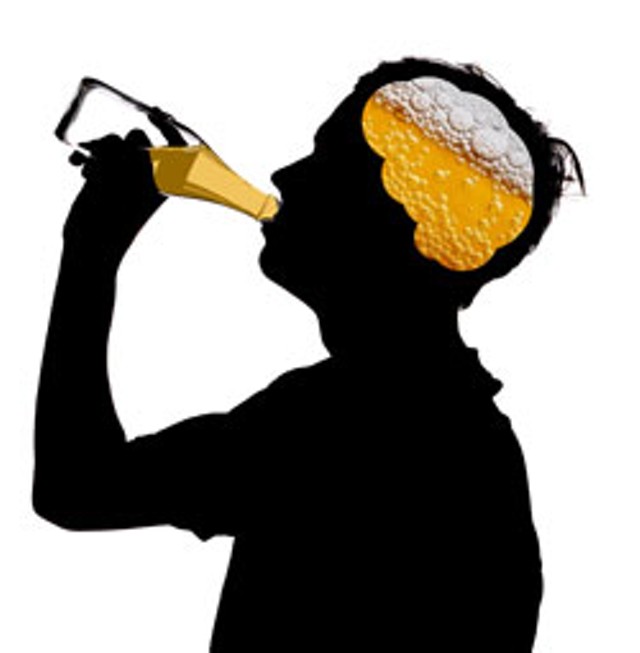Published January 16, 2013 at 11:18 a.m.
Vermont has earned a lot of “firsts” over the years, but the dubious distinction of No. 1 in the nation for underage drinking is nothing to brag about. According to the latest National Survey on Drug Use and Health (NSDUH), Vermont tops every other state in drinking rates among youth ages 12 to 20, with a whopping 37 percent.
The Green Mountain State is no stranger to high rates of youth drinking — though they’ve actually decreased since the 1990s, says the state’s drug and alcohol czar, Barbara Cimaglio. Still, Vermont’s position at the top spotlights a pervasive problem that foreshadows far-reaching consequences. One concern is how alcohol affects kids’ brains during a vulnerable period of development, possibly setting them up for a long struggle with addictive disorders.
“The research is pretty clear that for young people who start to drink regularly before the age of 15, the risks of lifelong problems with alcoholism and other drug dependence are greatly elevated,” says Cimaglio, who is deputy commissioner for Alcohol & Drug Abuse Programs at the Vermont Department of Health.
“The age at which kids start to use alcohol is the most robust predictor of who gets alcoholism later on,” says Marisa Silveri, a Harvard neuroscientist who studies the effects of alcohol on the developing brain. Youths who start drinking at age 14 or earlier have a sevenfold risk for alcohol disorders compared with those who hold off until age 21 or later.
Of course, alcoholism is just the tip of the iceberg. The NSDUH called alcohol use “one of the most serious public health issues for young people in the United States, creating negative health, social and economic consequences for adolescents, their families, communities and the nation as a whole.”
Those consequences add up to big bucks, and states do the lion’s share of mopping up the wreckage of lives lost to alcoholism. Fifteen years ago, the mop soaked up about 12 percent of Vermont’s total budget, including costs of health care, social services, child welfare, justice and law enforcement, and more. In a sweeping 2001 analysis of states’ costs by the National Center on Addiction and Substance Abuse at Columbia University, the authors called alcohol and substance abuse “the elephant in America’s living room.” In Vermont, the elephant hasn’t budged; it’s just becoming harder to ignore.
One reason is the teenage brain’s vulnerability to alcohol. Adolescence to young adulthood is a period of rapid change in the developing brain, which doesn’t reach full maturity until at least the mid-twenties. Beginning around puberty, the brain starts to resculpt itself dramatically, first with a surge, then a purge. Connections between nerve cells proliferate rapidly as the brain sets up a rough scaffolding for the “wiring” that will see it into adulthood. Then the brain undergoes a massive “pruning” of neurons and connections that are deemed unnecessary.
You’ve heard of “use it or lose it”? The brain takes this literally as it reshapes itself in accordance with the information it receives from its environment. Brain cells that get used are retained in the system, while those that aren’t active wither and die. Flood the system with alcohol in the midst of this process, and you may be priming the brain for alcohol dependence.
“You’re reinforcing a maladaptive reward system. It’s a setup for a lifelong struggle with addiction, because you’ve got a brain that sees maladaptive behavior as rewarding,” says neuroscientist Jordan Grafman of Northwestern University.
Nowhere is the brain’s remodeling more dramatic than in the all-important frontal lobes, the forward-most part of the brain and the last section to mature. This is where “higher cognition” takes place — decision making, impulse control, planning, social skills, and the ability to make good judgments and put the brakes on inappropriate responses. Think of the frontal lobes as the brain’s CEO, quashing crazy impulses and reacting appropriately when faced with important decisions. In teens, the CEO hasn’t quite moved into the corner office yet.
Neuroscientist Silveri likens the adolescent thought process to driving a vehicle without brakes or guardrails. Fast. On a slippery mountain slope. Add alcohol, and you’ve got a recipe for risk taking.
The brain science of adolescence helps explain teenagers’ heightened vulnerability to alcohol, but it does little to explain why Vermont’s rate of underage drinking is so much higher than the national average. The rural nature of the state, the high number of colleges and universities, and more liberal social views are some of the reasons experts and advocates note, but there is no clear answer. “We really don’t know why,” the health department’s Cimaglio admits.
Impossible to ignore is the “drinking culture” that society has created, in which alcoholic beverages are flavored, packaged and marketed to appeal to youth; in which beer ads dominate sports broadcasts and drinking is portrayed as the path to great fun and hot hookups. Liquor companies deny marketing to youth, but there’s a powerful incentive to do so: Nearly 20 percent of consumer spending on alcohol came from underage drinking in 2005, making it a $22.5 billion market then. Pathological drinking, for which early users are at heightened risk, racked up another $25.8 billion for the liquor industry.
While that culture of drinking is everywhere, underage drinking is anything but uniform across the country. In the Northeast, five New England states and New York are in the top 10 for underage drinking; the lowest rates are seen in the South. What makes this region different? Are we genetically predisposed by some risk-factor gene? Are we self-medicating with alcohol to quell anxiety or feel less depressed? Is a hot toddy the best way through a long, cold winter?
The state may not have answers, but Cimaglio says underage drinking is the top priority of the health department’s addiction-prevention programs, which had a total budget of about $2.1 million in 2012. Increasing awareness is the cornerstone of these programs, via community-based outreach and parental-education campaigns such as Parent Up (parentupvt.org), a website aimed at helping parents talk with their kids about alcohol and drugs.
Colleges bear a large share of the burden of underage drinking — Vermont has the highest number of colleges and universities per capita of any state, according to Ann Gilbert of Central Vermont New Directions Coalition. Some colleges have taken proactive measures to reduce on-campus drinking, which can be effective when most students live on campus but do little to help when students just have to walk down the street to a drinking party. Usually, serious responses are reactive — a review of a college’s drinking culture after a sexual assault, say, or after a fatal accident involving alcohol.
The current or former presidents of eight Vermont colleges and the former chancellor of Vermont State Colleges are among the 136 nationwide who have signed on to the Amethyst Initiative, an effort started by former Middlebury College president John McCardell to “rethink” the drinking age.
The state sponsored a symposium at Norwich University in October that brought together representatives from 16 Vermont colleges and universities to “both inform and charge them to look at this issue and whether they are meeting the suggested policies that have been established,” Cimaglio says. A work group has been formed to keep the dialogue going.
The state also works with local groups such as New Directions, which brings alcohol-prevention messages to youths, college students, retailers and parents in Washington County. One program promotes the idea of “Live More Drink Less” through social-media contests and an eCheckup To Go tool that can be used to assess one’s own drinking behavior confidentially online in about 15 minutes.
Is education enough? It’s hard to find strong evidence that alcohol- and drug-abuse education actually translates to behavioral changes in youth. A 2010 federal survey found no difference in alcohol use among young people who had seen or heard drug- or alcohol-prevention messages compared with those who didn’t get the memo. Vermont reported somewhat more encouraging results last year, finding modest decreases in underage drinking and binge drinking after community-planned and -implemented prevention programs in 24 Vermont municipalities, covering about 70 percent of the population.
A five-year (2007-2012) federal incentive grant funded evidence-based programs tailored to each community, with informational campaigns, in-school programs, liaisons with law enforcement to enforce relevant laws and more. These local-born efforts are “where we see the biggest impact,” Cimaglio says. Apparently, preventing alcohol use in teens takes a village.
But, experts say, it also takes a parent or two who pay attention to where their kids are and what they’re doing, who have honest, open conversations about drinking and who don’t send mixed messages that teen drinking is OK — even at home under supervision.
“Parents’ position on drinking is one of the strongest protective factors against underage drinking,” says Harvard’s Silveri. “Parents need to be the guardrails, be their frontal lobes.”
The print version of this article was headlined "Teen Brains on Booze".
Speaking of...
-

Waterbury’s Craft Beer Cellar Gets a New Name — and a Bar
Feb 27, 2024 -

Video Guide: Things to Do in Vermont During the Eclipse
Jan 25, 2024 -

Winooski’s Vermont Homebrew Supply to Close
Jan 16, 2024 -

Morrisville’s Lost Nation Brewing Charts a Path Through a Changing Beer Landscape
Jan 9, 2024 -

'We Must Act Now': Burlington Council Passes Resolution on Drug Crisis, Public Safety
Oct 11, 2023 - More »
Comments
Comments are closed.
From 2014-2020, Seven Days allowed readers to comment on all stories posted on our website. While we've appreciated the suggestions and insights, right now Seven Days is prioritizing our core mission — producing high-quality, responsible local journalism — over moderating online debates between readers.
To criticize, correct or praise our reporting, please send us a letter to the editor or send us a tip. We’ll check it out and report the results.
Online comments may return when we have better tech tools for managing them. Thanks for reading.











































